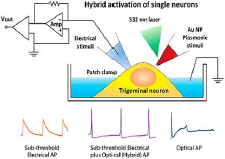Competitive Advantages
- Better spatial resolution than standard electrical stimulation
- Capable of reducing electrical stimulation current input by 40%
- Specific point stimulation, reducing spread to surrounding tissue
- 3-fold higher success rate of nerve cell response compared to pure optical stimulation
- 5-fold better post-stimulation recovery/survival rate of stimulated neurons, compared to pure optical stimulation
- Tunable properties
Summary
Our inventors have developed a next-generation, hybrid electro-plasmonic stimulation platform for spatially and temporally precise neural excitation. Neurons are co-stimulated with a sub-threshold level, short duration electrical and visible light pulses (1-5 ms) aimed at a gold nanoparticle-coated nanoelectrodes placed adjacent to a nerve cell. Gold nanoparticle-coated nanoelectrodes convert visible light pulses into localized surface plasmon resonance transduction in the vicinity of the nanoparticles. This allows for action potential initiation and stimulation of the nerve cell. Recorded membrane action potentials showed a 3-fold higher success rate and 5-fold better post-stimulation cell recovery rate than with pure optical stimulation alone. Also, electrical stimulus current input is reduced by up to 40%. The subthreshold levels of electrical stimuli in conjunction with visible light (532 nm) reliably triggered trains of action potentials, without cell damage as observed with pure optical stimulation. This breakthrough, utilizing hybrid electrical and optical pulses, is expected to enable future neural stimulation implants, including cochlear implants, cardiac pacemakers, sciatica, vagus nerve, transcorneal electro-plasmonic stimulation and other, to work more precisely, with better spatial and temporal resolution than what is currently available.

Graphic Depiction of Experimental Setup
Desired Partnerships
- License
- Sponsored Research
- Co-Development